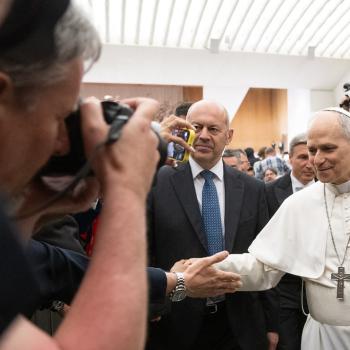 The second half of the Prologue of John focuses on the coming of the Word-Light into the World, and World's reaction. John testifies that the Light has come to enlighten the World (1:6-9). The World, on the other hand, does not know or accept the Word (1:10-11). Those who do accept the Word become reborn as children of God (1:12-13). When the Word becomes flesh, it thereby reveals grace, truth, and the glory and knowledge of the Father (1:14-18). In a sense, these verses summarize the major themes of the rest of John's Gospel.
The second half of the Prologue of John focuses on the coming of the Word-Light into the World, and World's reaction. John testifies that the Light has come to enlighten the World (1:6-9). The World, on the other hand, does not know or accept the Word (1:10-11). Those who do accept the Word become reborn as children of God (1:12-13). When the Word becomes flesh, it thereby reveals grace, truth, and the glory and knowledge of the Father (1:14-18). In a sense, these verses summarize the major themes of the rest of John's Gospel.
1:6-8, the Testimony of John the Baptist
At first these three verses seem like an interruption or a digression within the description of the role of the Word. The "man sent by God" in 1:6 is John the Baptist (or "Baptizer" or, more literally, "Immerser"), whose story is told in detail in John 1:19-42. Here the Gospel describes the Immerser as "a man sent from God" (1:6), in other words, a prophet. Each biblical prophet had a special mission from God, and John's mission is that of prophetic forerunner to testify of the messianic Light (1:7-8), that is, to testify of the Word/Jesus. As we shall see next week, John's role as witness to the Light has a crucial function in the Gospel. John takes great pain here to emphasize that John the Baptist is not "the Light," that is, the Messiah (1:8, 20). Rather, the Baptist's role is to testify of the authenticity of the Word/Light/Messiah (1:9). The specifics of John the Baptist's testimony of Jesus will discussed in the section on 1:19-42 in next week's column
1:9-13, Word and World
In John 1:9-13 there are three different responses to the manifestation of the Word-Light in the world: 1) the world does not know him, 2) his own people reject him, but 3) the disciples believe in him. The implications of the different responses of these three groups to the manifestation of the Word-Light is a central theme of John's entire Gospel, and will be further developed throughout the following weeks.
In 1:9-10 the true Light comes to the world, which does not know him. The Greek term kosmos, generally translated as "world" in most modern translations, can mean the material or physical world in which we live, the inhabitants of that world, and even the natural and social order of the world. John, however, has a more technical sense in which he uses the term kosmos. In this special sense the kosmos is the natural and human order that stands in antithesis and opposition to Jesus and the disciples. On the other hand, paradoxically, although the kosmos was created and loved by God, and is something that God wants to save, yet the kosmos is an enemy to the Messiah and his disciples (Jn. 7:7, 15:18). I will develop these ideas further in my discussion of John 3.
John's next verse says that Jesus "came unto his own (ta idia) and his own (hoi idioi) did not accept him" (1:11). English translations of this passage can sometimes obscure the meaning of the Greek. In Greek Jesus "came to his own [idia, things/places, neuter plural], and his own [idioi, people, masculine plural] did not accept him." That is, Jesus came to his own land/place, and his own people, the Israelites, did not accept him. The first idia does not refer to the kosmos, which had already been discussed in the previous verse. Rather it is plural, and refers to Jesus coming to his own places (Jn. 4:44, 13:1, 15:19)—that is, the lands of Galilee and Judea, Jerusalem, and, most importantly, as we shall see, the temple. This verse is thus allusive of the eventual rejection of Jesus by "his own [people]," as described throughout the Gospel, but culminating in John 19:13-16, where his own people reject him as Messiah, declaring, "we have no king-[messiah] than Caesar" (19:15).
Those who accept Jesus, on the other hand, become the children of God, and are "born of God" (1:12-13). Indeed, one of the purposes of Jesus' mission is to: "gather into one the children of God [that is, those who have been born of God, thus becoming his children] who are scattered abroad" (Jn. 11:52). It is worth noting that in John, only Jesus is called the "son (huios) of God"; the disciples are consistently called the "children (teknon) of God." The concept of becoming children of God will be analyzed in greater detail in my discussion of John 8.
1:14-18, The Word and the Believers
John 1:14 reads: "And the Word became flesh and dwelt among us, and we have seen his glory, glory as of the only Son from the Father, full of grace and truth." This verse introduces a number of ideas that are more fully developed throughout John's gospel.
- The Word became flesh. This is a fundamental concept: that Jesus, the preexistent divine Word, has become flesh (sarx), that is, a human being. The Greek term sarx means literally the meat, or fleshy part of a body, and hence, the body as a whole. It is sometimes used in the New Testament in opposition to spirit (pneuma), especially in Paul. This spirit-flesh duality is occasionally found in John (3:6, 6:63). Jesus' incarnation allows the complete fusion of the two. All of us, like Jesus, are born of the flesh, and all of us, through Jesus, can become born of the spirit (3:6). In a sense, the spirit becomes flesh so the flesh can become spirit.
- Entabernacled. John 1:14 is generally translated "the Word dwelt among us." The term "dwelt" in Greek is skēnoō, which means literally to "pitch a tent" (skēnē). It is an allusion to YHWH dwelling in a tent/tabernacle among the Israelites in the wilderness (Ex. 25:8-9, 33:7). The holy Tabernacle made by Moses for YHWH's dwelling place is frequently translated as skēnē in the Greek Septuagint. Thus, in the Hebrew Bible's conception, YHWH dwelt among ancient Israel in the Tabernacle, and later in the Temple (Ex. 25:8-9, 29:45, 33:9, 40:34-5; 1 Kgs. 6:13, 8:10-11; Ezek. 43:7; Zech 2:10-11). Now, however, God dwells among his people in dwelling of flesh, rather than fabric or stone, in the form of Jesus, the divine Word entabernacled. This verse introduces a crucial concept of Jesus' relationship to the Temple. As we shall see beginning in the discussion of John 2:13-25, for a 1st-century Jewish reader, the entire Gospel of John focuses on Jesus and the Temple, and Jesus as Lord of the Temple.
- "We have seen his Glory." In the 1st-century Jewish context, "glory" (doxa) does not mean merely magnificence or splendor. When John talks throughout his Gospel of the glory of Jesus, he is using the term in its technical biblical sense. In the Hebrew Bible, when God appears in his Temple, the dazzling light and splendor of his theophany is described as the "glory of the Lord" (kābôd YHWH) (Ex. 33:22, 40:34-48; Num. 14:10; Dt. 5:21-24; 1 Kgs. 8:10-11; Ps. 26:8, 102:15; Jer. 17:12; Ezek. 10:4, 11:23). It is important to note that these manifestations of divine glory almost always occur at the Temple or Tabernacle. When John says here that he has seen the glory of Jesus, he is saying that Christ is the "glory of YHWH," the physical and visible manifestation of the presence of God on earth. I will discuss this concept in detail later.
- Full of grace and truth. For John, grace and truth (charis and alētheia) are not merely abstract qualities possessed by Jesus. Rather, they are specific characteristics of God (Ex. 34:6; Ps. 25:10, 26:3, 40:10, 83:12; Prov. 16:6), which Jesus possesses because he is the Word incarnate. These terms probably translate the Hebrew phrase ḥesed we-'ĕmet, which is often translated as "steadfast love and faithfulness" or "lovingkindness and truth"). The importance of ḥesed/steadfast love/mercy/grace as a characteristic of YHWH is reflected in its repeated use as a liturgical refrain in Hebrew ritual (Ps. 118, 136; 1 Chr. 16:34; 2 Chr. 7:6, 20:21; Jer. 33:11; Ezra 3:11). It is precisely because God possesses ḥesed we-'ĕmet that he will forgive sins: "Because of steadfast love and faithfulness iniquity is atoned for" (Prov. 16:6). Thus, Jesus embodies grace and truth because he is God embodied. And because he fully embodies divine grace and truth, he can "take away the sins of the world" (Jn. 1:29).
- Law through Moses. Verse 17 reads: "For the Law/Torah was given through Moses; [but] grace and truth came through Jesus the Messiah." The "law" here is the Greek nomos and is an important technical term in the New Testament translating the Hebrew tôrāh, or Torah. Technically it refers to the commandments, statues, ritual system, and covenants given from God to Moses on Mt. Sinai. By the time of Jesus it generally meant the five books of Moses, or the Pentateuch. Of course all Jews would agree with John's statement that "the Torah was given through Moses," but why would John contrast that idea with the grace and truth of Jesus? John is here alluding to the theophany of YHWH to Moses in Exodus 34, when the stone tablets of the Torah were given to Moses (Ex. 34:27-29). On that occasion, YHWH "passed before the face" of Moses (Ex. 34:6), and said:





